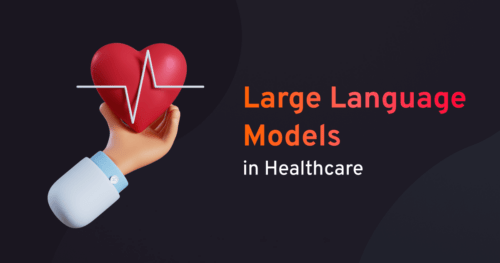How Medical LLMs Are Revolutionizing the Healthcare
Large language models (LLMs) in healthcare have garnered significant attention in the last twelve months. As interest in generative artificial intelligence (AI) and large language models continues to grow, providers of healthcare software are exploring ways to harness this technology within their clinical applications.
Medical LLMs are being utilized to enhance diagnostics, streamline patient interactions, and improve overall clinical workflows. Read on to discover how these advancements are transforming the healthcare industry.
Transformational Effect of Large Language Models in Healthcare
There is a critical need for guidance on integrating large language models and generative AI in healthcare and medical practices using technologies such as reinforcement learning from human feedback (RLFH), few-shot learning, and chain-of-thought reasoning, according to a PubMed study.
For example, large language models can be useful in clinical note summarization and achieve higher accuracy. Having the right LLM potentially enables excellent performance in extracting essential information and generating clear, concise summaries from complex clinical documents, enabling efficient review and understanding by healthcare professionals.
Such capabilities profoundly raise the utility and advantages of Artificial Intelligence as opposed to traditional, rule-based systems. They also encourage inclusive collaboration with relevant stakeholders, from clinicians to consumers. LLMs enhance data management, information retrieval, and decision-making.
Innovation in data acquisition, fine-tuning LLM, prompt engineering, LLM evaluation, and system implementation are all crucial elements of realizing the benefits of these technologies. The PubMed study recommends proactively engaging with foundation models to provide high-quality healthcare service, patient safety, and efficiency while following ethical and legal guidelines for responsible governance.

LLM Use Cases in Healthcare
Large Language Models play a crucial role in administrative tasks such as clinical practice and documentation, medical research, and patient care. Medical large language models elevate patient care by analyzing vast amounts of medical literature, clinical records, and scientific papers with precision and speed. They provide valuable insights, aid in accurate diagnoses, assist in treatment planning, and support healthcare professionals in making informed decisions.
Virtual Medical Assistants
68 million adults in the USA have two or more chronic diseases, demanding a tenfold increase in care capacity. LLM-powered AI assistants can enhance telemedicine by understanding and responding to patient queries, providing medication reminders, offering general health information, and helping with medical question answering to improve patient engagement.
Clinical Documentation and Electronic Health Records
Leveraging large language models in the healthcare industry can efficiently summarize extensive patient notes, reports, and medical histories, assisting healthcare professionals in quickly extracting relevant information and insights.
This not only saves substantial time spent on manual data analysis and documentation but also enhances accuracy. This enables the healthcare providers to redirect their focus and energy towards more personalized and impactful patient care.
Adverse-Event Detection
According to the National Library of Medicine Sources of Safety Data and Statistical Strategies for Design and Analysis: Postmarket Surveillance, “LLMs can potentially automate the detection of adverse events from electronic health record data and may support surveillance of drug safety in the post-marketing setting using new data sources.”
There have been impressive advances in understanding natural language processing following the release of context-aware deep learning models such as bidirectional encoder representations from transformer architecture and models like (BERT) and now GPT-4. However, the presence of identifiable patient information in clinical notes obstructed research in this area.
Challenges of Implementing Large Language Models in Healthcare
Although medical LLMs hold the potential to enhance healthcare, it’s crucial to address the challenges associated with this new and rapidly evolving technology.
Privacy and Data Security
Leveraging LLMs for healthcare holds immense promise, but privacy and data security concerns loom large. Sensitive patient medical data, algorithmic bias, lack of transparency, data silos, and evolving regulations demand careful attention. Utilizing the TRAPS framework in generative AI to Secure data-sharing protocols to safeguard individual privacy along with explainable AI techniques that demystify LLM-driven decisions are essential for fostering trust.
Existing regulations like HIPPA and GDPR offer a framework for all medical records and data protection but the rapid evolution of LLMs demands continual adaptation and potential expansion of these regulations.
Over-Reliance on Artificial Intelligence Technology
Placing indisputable credence in machine learning AI technology can reduce valuable human input in critical decision-making processes. Healthcare providers and medical professionals must be conservative and cautious about interpreting outputs and focus on augmenting human expertise rather than replacing it.
The human element must remain central in patient care. Another challenge is that LLMs can unintentionally output misleading or incorrect information, which can lead to negative consequences in healthcare settings if AI is unquestioningly accepted as correct or accurate.

The Future of Large Language Models for Healthcare Providers
The future of large language models (LLMs) stands as a beacon of transformative potential for healthcare providers. These advanced AI systems, harnessing the power of vast data and sophisticated algorithms, promise to revolutionize how medical professionals diagnose, treat, and manage patient care, leading to a new era of personalized and efficient healthcare services.
Predicting cancer metastasis
LLMs are now being used to predict cancer metastasis and to assist in devising clinical treatment responses. Cancer-progression patterns are extracted from vast numbers of computed tomography reports for analysis by a natural language processing model; they can then predict metastatic disease in multiple organs. This model and its treatment data can point the way toward specific therapies and enable a better understanding of population-level cancer treatments and how drugs work in the real world.
Conversational AI Diagnostics
Large language models are being integrated into predictive systems, especially in the field of medical imaging to deliver images with high diagnostic accuracy. It can potentially go even further by integrating screening and diagnosis with the LLM-powered Conversational AI platforms.
This approach would allow a clinician to converse with and interrogate a system, draft a report, or improve an existing report. Integrating LLMs and conversational AI in healthcare including in clinical and medical settings, and systems that accurately read mammograms and other images are becoming more feasible every year.
Drug Discovery and Development
The use of LLMs especially generative AI in pharma and biotech industry can drive substantial competitive advantages, spanning cost efficiency, accelerated timelines, and enhanced innovations in clinical trials.
As LLMs evolve by incorporating empirical data and domain expertise, these models can be fine-tuned further to provide valuable insights and solutions. With their ability to analyze large volumes of data, LLMs have the potential to help predict drug interactions, side effects, and efficacy, expediting the drug discovery process and driving cost reductions.

Choosing the Right Models for Healthcare
As organizations explore the capabilities of an enterprise LLM and implement Artificial Intelligence solutions that advance us toward a future where healthcare is increasingly personalized and effective, it is important to consider the following factors:
- Intended use case
Consider whether you will be using the LLM for content generation, classification, translation, etc. Which are the core tasks you expect it to perform? - Data Domain
If you are a healthcare organization, you will want to have a domain-specific LLM, that is pre-trained on relevant and highest-quality data. - Ethical considerations
Educate yourself on potential biases, safety considerations, and risks of misuse depending on your use case. - Accuracy
Will you need high precision or is moderate accuracy acceptable? Larger models are generally more accurate. - Scalability
Are you considering a large number of users? How many thousands of queries per second do you anticipate? Scaling can be costly. - Cloud vs on-premise
Cloud API access can bring you ease and convenience but on-premise offers greater control and opportunity for customization. - Budget
Consider the range of pricing based on compute usage, queries, and model size. Weigh cost and capabilities. - Inference speed
Smaller models may be faster. How important is real-time low latency?
According to Nigam Shah, PhD, MBBS, chief data scientist for Stanford Health Care, “We call it ‘LLM bingo,’ where people check off what these models can and can’t do. ‘Can it pass the medical exams? Check. Can it summarize a patient’s data and history?
Check.’ While the answer may be yes on the surface, we’re not asking the most important questions: ‘How well is it performing? Does it positively impact patient care? Does it increase efficiency or decrease cost?’”
Shah, speaking in the Journal of the American Medical Association (JAMA) discussed in more detail the needs of the medical field in harnessing LLMs. Concerns range from evaluating algorithm accuracy to ensuring the LLMs fit with the workflow.
He also mentions the importance of knowing who made the LLM, which data it was trained on, and whether the data applies to multiple populations. Addressing AI hallucinations and understanding mistakes are of high priority because “in health care, you can’t afford factual errors.”
Conclusions
LLMs present a significant opportunity to transform medical education, and practices to enhance diagnostic accuracy. Ensuring reliability and precision in LLM-generated outputs is critical because errors can lead to incorrect diagnoses, the wrong treatment, or negative outcomes. Rigorous validation processes, constant monitoring, and working closely with experts are essential. Medical professionals should have enough medical knowledge to understand and explain the reasoning underlying LLM-generated results.
Integrating large language models into healthcare is also accompanied by investment and cost implications. Developing, training data, and maintaining LLMs demand robust computational resources, which may prevent optimal adoption, especially for those with lower available funding. Developing efficient models that require less computational power while concurrently performing at a high level is ideal, of course.
Relying on the cloud can help providers access AI capabilities and bring AI and Automation to healthcare without costly hardware and infrastructure investment. Public and private sector collaboration will also help improve quality healthcare outcomes for diverse, high-needs populations. Book a free custom AI demo for healthcare and clinical settings today!

